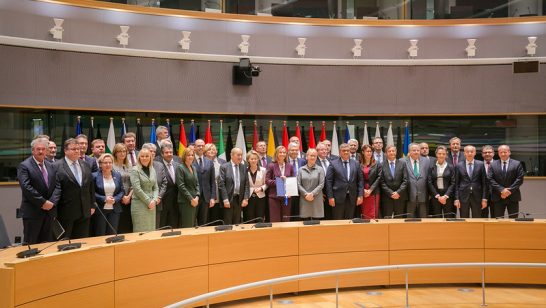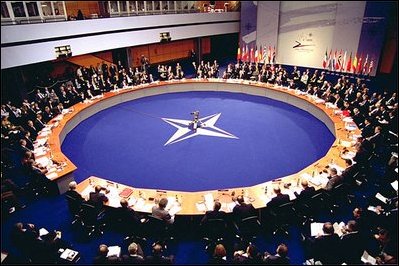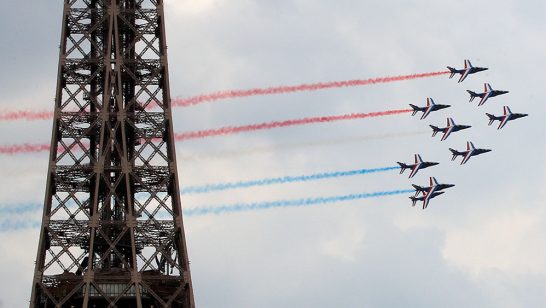
As NATO prepares to celebrate its 70thanniversary, allies seem unenthusiastic about throwing a party. The gathering in Washington to mark the 1949 signing of the Treaty has now been downgraded to a meeting of Foreign Ministers, and Heads of States and Governments are scheduled for a summit in London in December.
This anniversary could have been a perfect occasion to reflect on NATO’s role in today’s world. For the last five years, politicians and experts have talked of a new and fundamentally changed security situation, yet there seems to be little appetite among allies to engage in such a discussion, let alone start the process of writing a new strategic concept. The main reason for this being deepening rifts in the transatlantic relationship. Since taking office, US president Donald Trump has repeatedly questioned the value of multinational cooperation and threatened to withdraw America’s engagement in Europe if allies do not pay more. Recent speeches by Secretary of State Mike Pompeo in Brussels and Vice President Mike Pence in Munich suggest that Washington wants to impose an “America first” logic on allies.
At the same time, the European Union has struggled to live up to its ambition of taking more responsibility for the continent’s security. Calls for a European army and greater strategic autonomy remain notoriously vague and are often misrepresented as being against the US and NATO. Worse still, they have had a decidedly provocative impact on Europe’s American allies.
However, in this climate of uncertainty and distrust, it is sometimes overlooked that American and European allies have together embarked on a comprehensive agenda and come a long way in its implementation. First agreed at NATO’s Wales summit in 2014 and developed at consecutive summits in Warsaw 2016 and Brussels 2018, the agenda’s overall goal is to improve readiness through a wide set of initiatives.
A key element of NATO’s new or “modern” deterrence and defence posture is a set of rapid response forces. Instead of setting up permanent military bases on the eastern flank, allies agreed to emphasise their ability to react rapidly to a crisis. Wales established the Very High Readiness Joint Task Force (VJTF) to spearhead NATO’s pool of response forces to meet eastern European demands, and a rotational forward presence of multinational troops was added. In a parallel but connected move, the United Kingdom established the Joint Expeditionary Force (JEF) and, more recently, France invited a select group of nations to join a European Intervention Initiative (E2I).
Other initiatives have aimed at improving military mobility. Allies quickly realised the extent to which legal barriers and inadequate infrastructures hampered the movement of troops and materiel across Europe and, as early as 2015, the commander of US Army Europe, General Ben Hodges, called for a form of a military Schengen zone inside NATO. Consequently, the EU and NATO have made improving mobility a priority and turned it into a flagship project for cooperation.
As part of these efforts, allies stepped up training and exercising. Last year’s Trident Juncture NATO exercise hosted by Norway was not only the biggest exercise since 2002, but also the first time allies had trained to deploy a large multinational force to the Northern flank. Updating response plans and reforming NATO’s command structure with a view to logistics and securing sea lines were other important measures in improving its readiness.
If mobility improvements, streamlined decision-making, and readiness have been on top of the allied agenda, investment in military capabilities have stood right beside it. For most allies this has meant closing capability gaps widened over decades of budget cuts and placing an emphasis on crisis-management operations. Europeans have also joint forces to develop new technologies and weapon systems for future conflicts. NATO endorses capability cooperation under the German led Framework Nations Concept (FNC) as well as supporting a number of other multinational projects; EU member states agreed in 2017 to encourage projects under the concept of Permanent Structured Cooperation (PESCO); and a European Defence Fund (EDF) is meant to secure more sustainable funding for capability development. Procurement agreements among two or several partners are beginning to complete this picture.
Yet, in order to be successful, these initiatives need to follow basic guidelines.
First, they must involve all levels of the Euro-Atlantic security architecture. Whilst NATO and the EU are able to provide the wider framework, much of the actual cooperation takes place in smaller groupings of member states. It is hard to think of a capability project or operation that can be implemented by a single state or organisation in isolation. Response forces are deployable for NATO but also for EU and UN-led missions or in dedicated coalition frameworks. Countering hybrid threats and ensuring military mobility requests NATO-EU cooperation, but member states must also implement legislation and build critical infrastructures. As Trident Juncture demonstrates, readiness depends not only on host nation support, but also on member states to ensure civil-military cooperation arrangements.
Second, all initiatives should support a 360-degree approach. While the main change provoked by Russia’s illegal annexation of Crimea was a renewed focus on NATO’s core mission of collective defence, today’s complex security environment and divergent priorities of member states requires a broader outlook. Thus response forces and headquarters are not only oriented to confront a major opponent in an article 5 scenario, but continue to be ready for crisis management and stabilisation operations. Some have suggested a future division of labour in which NATO concentrates on collective defence and the EU takes on crisis-management. More likely, however, is that both organisations will have to adjust and diversify their toolboxes and step up cooperation in order to confront an increasingly complex set of security challenges.
Third, all endeavours require allies to spend more. Allies have stepped back from the logic that smart defence can help in cutting costs. Reacting to the strategic shocks of 2014 and under increased American pressure, states now accept the need to spend more and increase multinational cooperation at the same time. It remains a cause of disagreement whether the 2 % of GDP goal is to be taken literally or if moving towards it is enough. However, if the current positive trend continues and both parts abstain from politicising the issue, disagreements on defence spending may cease to dominate every summit and transatlantic encounter.
Lastly, the United States has to remain an essential part in all initiatives – as a lead nation, contributing partner through NATO, or through bilateral agreements. Implementing the Wales agenda serves the double purpose of ensuring America remains engaged in European security and strengthening the European pillar of NATO. In the longer term, closer cooperation among Europeans may also help reduce dependence on US troops and capabilities. However, given how limited Europe’s military capabilities are today and how unambitious the EU’s PESCO projects remain, the vision of autonomy currently fails the reality check.
Organised in many different formats and frameworks, European security appears fragmented. Harmonising islands of cooperation is necessary to avoid duplication and increase effectiveness. It is illusionary to think such harmonisation could happen top-down as part of a grand design. More likely, the Euro-Atlantic security architecture will continue to evolve through a bottom-up approach – and this is not necessarily a disadvantage. At the military level, an increase of multinational cooperation from joint training to integrated units creates positive energy and enthusiasm. Moreover, the flexible nature of European defence cooperation makes it easier to integrate countries outside the EU or NATO. This structure applies today for non-EU member Norway and non-NATO countries Sweden and Finland – and will be important for a post-Brexit United Kingdom.
The question remains if a pragmatic and flexible bottom-up approach to defence cooperation is enough to prepare the West for security challenges, particularly those requiring more than rapidly moving tank battalions across Europe. The answer is probably not, but so long as transatlantic differences stand in the way of comprehensive strategic reflection, continuing to implement the Wales agenda seems a good way to preserve NATO’s greatest strength and strategic advantage: unity and cohesion.
The opinions articulated above also do not necessarily reflect the position of the European Leadership Network or any of its members. The ELN’s aim is to encourage debates that will help develop Europe’s capacity to address pressing foreign, defence, and security challenge.



